With the cyclocross season nearly afoot, it is a good time as any to revisit every cyclocross rider’s favorite skill: running. U.S. amateur races are typically not as run-heavy as professional European races – although Jingle Cross’s Mt. Krumpit looms large for many U.S. racers – but running sections can still make the difference between making the podium and finishing fourth or losing a tight battle to your race nemesis. In today’s Training Tuesday, Coach Chris Mayhew gives his advice for mixing some running into your cyclocross training.
The issue of running is the dress of cyclocross; it is black and blue or white and gold, it is irrelevant or it is something you need to train extensively. As a coach and an athlete I have had some good experiences with running this year and plan to incorporate those experiences into my coaching this fall. This topic has been a popular one with my clients so I would like to share my thoughts with them along with a larger audience here at Cyclocross Magazine.
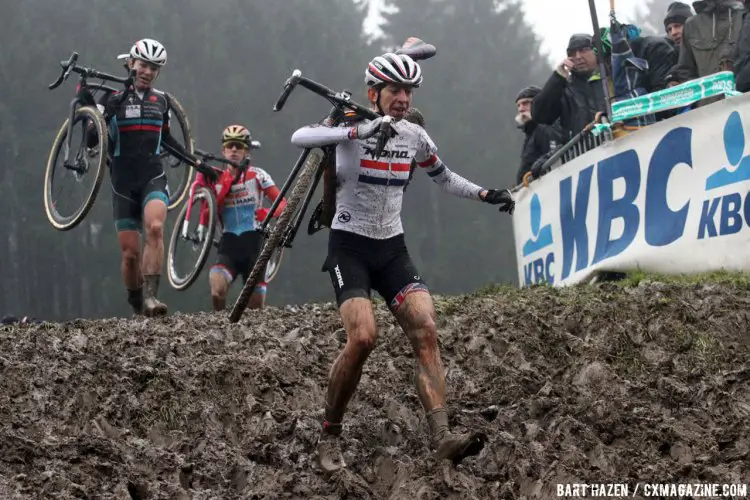
You never know when the weather is going to force you to run. Coach Mayhew argues it is probably a good idea to prepare to dismount and use foot instead of pedal power. Helen Wyman at Spa-Francorchamps 2015. © Bart Hazen
First, why run at all? Cyclocross is still a bike race at heart. However, some regions do require a bit of running, especially as conditions get worse into the late fall and early winter.
The first thing to think about when considering running training is if your region requires frequent and/or sustained running. Maybe you live in a dry area or perhaps your races are not particularly technical. In this case, your races may have almost no running and your training should reflect that.
If you do encounter a lot of running, are those races from the beginning of the season, or only as the weather dictates? Are you blessed with technical courses that require running no matter what the weather? Think Eva Bandman in Louisville with 6 dismounts per lap. If you are blessed (or cursed) as such, think about the kind of running they entail.
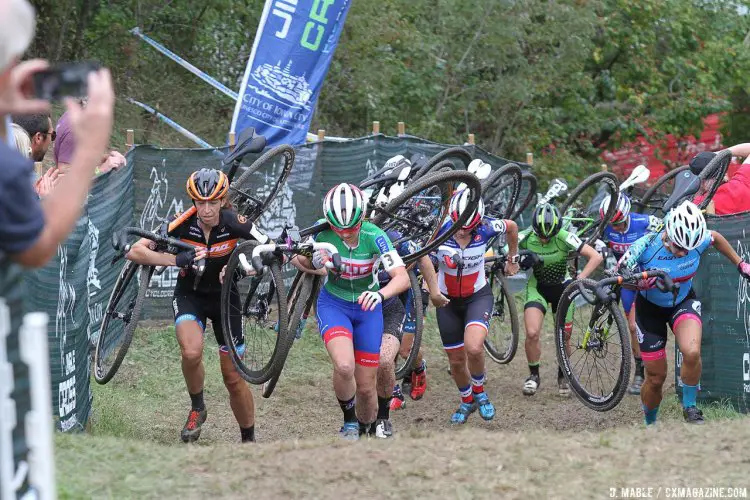
Going to Jingle Cross? You probably want to be ready to run up Mt. Krumpit several times. 2016 Jingle Cross Day 3 UCI C1, Elite Women. © D. Mable / Cyclocross Magazine
The usual guidance on running has been to start short – say five to ten minutes – then add a bit of time each week until you can run about 20 minutes without soreness. The idea is to essentially run enough that running ceases to be a unique stimulus to your body. These unique stimuli are usually the most acute cause of soreness. By the time September rolls around, most cyclocross racers have a finely tuned engine and reasonable transmission* (see the tail end of this column for bonus advice), but running’s unique stresses can still cause soreness.
When you look at the demands of cyclocross running you will see short intense efforts over short periods, often uphill, are most common. The biomechanics of that style of running have very little to do with those of ten-minute miles. To my mind, why bother with that type of effort, especially since so many athletes find it a chore. In addition, running in a cyclocross race does not take place in isolation as it might on a track. Incorporate ’cross skills such as dismounting and bike carrying into your running regime to make it more realistic. It is one thing to practice a carry standing still, but it is quite another to do it with a spiked heart rate after a 25-meter sprint.
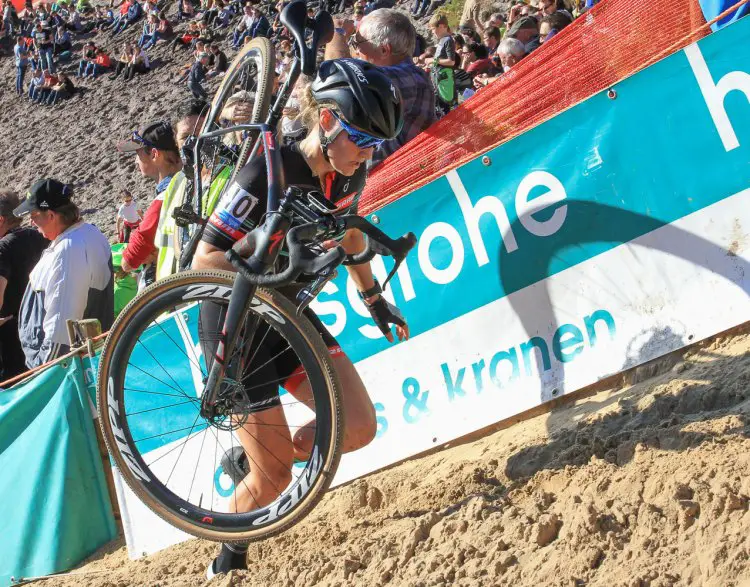
Cyclocross features short bursts of running, often on less than ideal surfaces. Your training should reflect this unique aspect of the sport. Elle Anderson at 2016 Superprestige Zonhoven women’s race. © Bart Hazen / Cyclocross Magazine
This advice may vary based on your specific training schedule, but an ideal day for running workouts is on Friday. My thinking is to take Monday easy or off, do solid workouts on Tuesday and Wednesday and then do another easy or off day on Thursday. With this schedule, Friday is a good day for some intensity and running.
When you first start running you will be a bit sore and doing it earlier in the week will compromise your training, whereas if you go into the weekend a tad sore on your long rides it will not matter as much, hopefully. On your Friday run day, let’s keep it short and focused on both skill and conditioning components. A good tip for ’cross workouts I have learned is to keep that as close to home as possible. Daylight will be a waning commodity during each successive week.
For the first few weeks, bring some running shoes to this workout, although ideally you will transition away from using them. Get off the bike and do a brisk walk or jog for 1-2 minutes, mainly to acclimate your ankles. If you have ever done a dismount on a cold day with no warm up then you know how much it hurts. Get in the habit now.
From there let’s practice shouldering skills while you are rested. Whether you are a Cat 5 or Cat 1 racer, the focus should be on doing these right, not fast. Fast is slow, slow is smooth, smooth is fast. If that means shouldering your bike while standing still, do that. If that means staying stationary next to your bike while shouldering it, do that. The goal is to nail ten reps of perfect form.
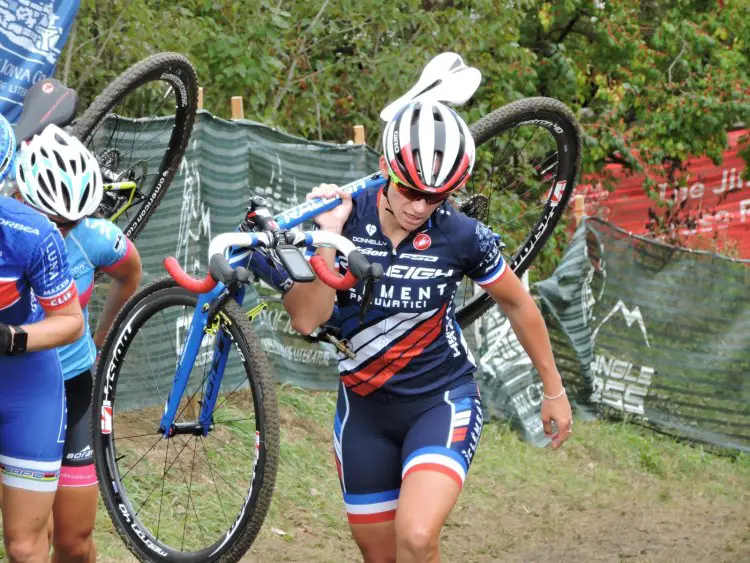
Riders of all skill levels should practice proper shouldering technique before the season. photo: Zachary Schuster
Now we move to the hard part. Start with a short target distance of running that meets your current fitness level and keep the number of running reps low to begin. An example beginning workout would be to ride to the base of some stairs, dismount, shoulder the bike, run and then remount at the top. You will want the recovery period to be around two minutes, assuming the intervals are around 30 seconds or so.
If you are doing flat ground running, which is rare on cyclocross courses these days outside of sand, ride, run 25 meters, remount and then recover. Do six or so of these at the outset. I know it does not sound like much but get back to me on Sunday when the delayed onset muscle sorenes (DOMS) sets in. If you feel you need more of a workout, you can initiate the effort with some cross starts to kick off the interval, bleed the speed off as you approach your target if need be, then hit the run.
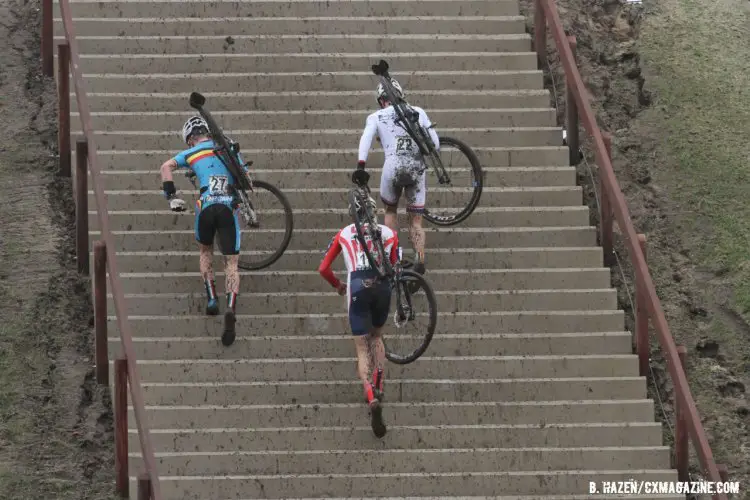
Stairs provide a good place to practice running. Gage Hecht 2016 World Cup Hoogerheide. © Bart Hazen
The goal of these workouts is to get some running done in a manner specific to cyclocross. If you want to add skills or other bike work around it, as outlined above, that is great too. If you are running stairs just add more reps, say two per week. If you are running for distance, add ten meters or so per week until you’re at the distance you need to simulate in a race. Keep in mind the UCI limit is 80 meters for a designed running section.
However you accomplish the work, here are the main takeaways in my mind:
1. Figure out if you need to run at all. I can think of regions and series where training for running would be extraneous.
2. If you do need to run keep it short to begin with, both in the duration of the run and the total number of reps. You can always add more later, but doing a ton of work the first few times is just going to compromise later workouts and may lead to injury.
3. If you do need to run, what kind of running is it? Uphill? Sand? Flat ground? Devise a workout that simulates the specific sort of running you need to keep it mentally engaging. Plus the shorter runs keep you on your toes, literally. That style of running maximizes your body’s natural running style versus doing 20 mins of heel striking at a jogging pace. And if it causes more pain than DOMS, please stop doing it!
I think you can, as an athlete and human, do some running, and you probably should. Don’t be afraid of it, make it interesting, and keep it safe.
*Drop It Like It’s Squat for Better Knee Stability
I certainly cannot or should not diagnose you the individual and your pains, but I think a lot of the issues people have with running ultimately come down to weak glutes, sometimes even specifically the glute medius which plays a very big role in knee stability. If you know that knee pain from running is an issue for you, I would suggest laying some ground work now, months before you need to do any sort of running work.
Take a look at Squat University or start with this article on using squats to improve knee stability. And of course, if you have a local resource to discuss the issue with go to them. You want someone who can lay eyes on your running and squatting form and offer an informed diagnosis.
Can’t get enough? Browse all of our Training and Technique Tuesday pieces here from coaches Mayhew and others. Mayhew expects to contribute Training Tuesday installments every two weeks in the off-season.




























